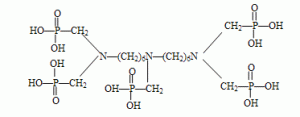Bis(HexaMethylene Triamine Penta (Methylene Phosphonic Acid)) BHMTPMPA
Synonyms: BHMTPMPA; BHMT; Bis(HexaMethylene Triamine Penta (Methylene Phosphonic Acid)); Dequest 2090; Gyptron KT-252; Mayoquest 1900
CAS No.: 34690-00-1
Molecular Formula: C17H44O15N3P5
Molecular Weight: 685
Structural Formula:
Properties:
BHMTPMPA is a high-efficient chelating scale inhibitor, it has a good effect on carbonate and sulfate scale. BHMTPMPA has good water-soluble properties and heat tolerance. Bis(Hexamethylene Triamine Penta (Methylene Phosphonic Acid) has high calcium ion tolerance in a wide pH range and temperature as high as 120℃.
BHMTPMPA has a good effect on inhibiting scale by chelation, especially to carbonate and sulfate scale. It can enhance the concentration ration in circulating water and reduce the consumption rate. Combined with ATMP and HEDP, BHMTPMPA has lower total phosphorus content and higher molecular weight.
Specification:
| Items | Index |
|---|---|
| Appearance | Dark amber liquid |
| Active component % | 43.0 – 48.0 |
| Chloride (as Cl–) % | 8.0 max |
| pH (1%water solution) | 2.0 max |
| Density (20℃) g/cm3 | 1.20 min |
| Fe, mg/l | 65.0 max |
Usage:
BHMTPMPA is mainly used in oilfield produced water and industrial cooling water as a corrosion inhibitor and antiscalant.
Package and Storage:
200L plastic drum, IBC (1000L), customers’ requirements. Storage for ten months in a shady room and dry place.
Safety Protection:
Acidity, avoid contact with eye and skin. Once contacted, flush with water.
Transport info:
Corrosive. IMO class 8, UN 3265.
BHMTPMPA scale inhibitor can remove scale and prevent the formation of scale. Improve heat exchange efficiency, reduce electrical energy, or reduce fuel consumption. Water treatment can also reduce blowdown and improve water utilization. Generally, it can save more than 60%.
From the mechanism of action, the role of the BHMTPMPA scale inhibitor includes chelation solubilization, aggregation and dispersion, electrostatic repulsion, and crystal distortion. And in the laboratory evaluation test, dispersion is a remedy for chelation, and lattice distortion is a remedy for dispersion.
Environmental protection is undoubtedly the development direction of water treatment chemicals in the 21st century. Therefore, the application of water treatment agents in the future should focus on three major goals. They are performance, economy, and environment. Further, improve existing products. On the basis of improving the quality, the mechanism research and compounding research should be strengthened. Reduce costs and reduce pollution.
In the synthesis of new products, we must break through existing ideas. Actively use green chemistry technology. Adopt a clean process to synthesize phosphorus-free, non-nitrogen, no toxic substances, easily biodegradable, and truly environmentally friendly and highly effective scale inhibitor to completely replace the phosphorus-containing formula.

